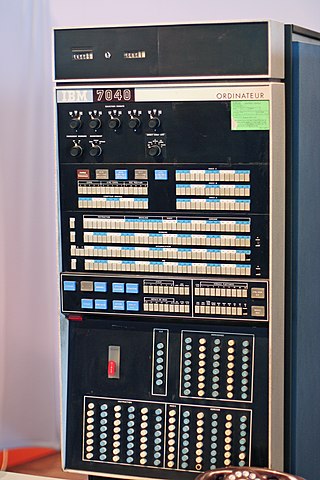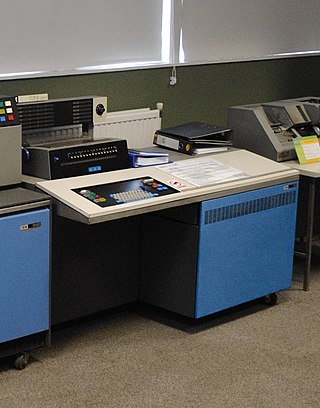IBM mainframes are large computer systems produced by IBM since 1952. During the 1960s and 1970s, IBM dominated the computer market with the 7000 series and the later System/360, followed by the System/370. Current mainframe computers in IBM's line of business computers are developments of the basic design of the System/360.
Computerized batch processing is a method of running software programs called jobs in batches automatically. While users are required to submit the jobs, no other interaction by the user is required to process the batch. Batches may automatically be run at scheduled times as well as being run contingent on the availability of computer resources.
MAD is a programming language and compiler for the IBM 704 and later the IBM 709, IBM 7090, IBM 7040, UNIVAC 1107, UNIVAC 1108, Philco 210-211, and eventually IBM System/370 mainframe computers. Developed in 1959 at the University of Michigan by Bernard Galler, Bruce Arden and Robert M. Graham, MAD is a variant of the ALGOL language. It was widely used to teach programming at colleges and universities during the 1960s and played a minor role in the development of Compatible Time-Sharing System (CTSS), Multics, and the Michigan Terminal System computer operating systems. The original version of the chatbot ELIZA was written in MAD-SLIP.

The IBM 7090 is a second-generation transistorized version of the earlier IBM 709 vacuum tube mainframe computer that was designed for "large-scale scientific and technological applications". The 7090 is the fourth member of the IBM 700/7000 series scientific computers. The first 7090 installation was in December 1959. In 1960, a typical system sold for $2.9 million or could be rented for $63,500 a month.

The IBM 700/7000 series is a series of large-scale (mainframe) computer systems that were made by IBM through the 1950s and early 1960s. The series includes several different, incompatible processor architectures. The 700s use vacuum-tube logic and were made obsolete by the introduction of the transistorized 7000s. The 7000s, in turn, were eventually replaced with System/360, which was announced in 1964. However the 360/65, the first 360 powerful enough to replace 7000s, did not become available until November 1965. Early problems with OS/360 and the high cost of converting software kept many 7000s in service for years afterward.

The IBM 7040 was a historic but short-lived model of transistor computer built in the 1960s.
The University of Michigan Executive System, or UMES, a batch operating system developed at the University of Michigan in 1958, was widely used at many universities. Based on the General Motors Executive System for the IBM 701, UMES was revised to work on the mainframe computers in use at the University of Michigan during this time and to work better for the small student jobs that were expected to be the primary work load at the university.

The IBM 1130 Computing System, introduced in 1965, was IBM's least expensive computer at that time. A binary 16-bit machine, it was marketed to price-sensitive, computing-intensive technical markets, like education and engineering, succeeding the decimal IBM 1620 in that market segment. Typical installations included a 1 megabyte disk drive that stored the operating system, compilers and object programs, with program source generated and maintained on punched cards. Fortran was the most common programming language used, but several others, including APL, were available.
The Job Entry Subsystem (JES) is a component of IBM's MVS mainframe operating systems that is responsible for managing batch workloads. In modern times, there are two distinct implementations of the Job Entry System called JES2 and JES3. They are designed to provide efficient execution of batch jobs.
Autocoder is any of a group of assemblers for a number of IBM computers of the 1950s and 1960s. The first Autocoders appear to have been the earliest assemblers to provide a macro facility.
SHARE Inc. is a volunteer-run user group for IBM mainframe computers that was founded in 1955 by Los Angeles-area users of the IBM 704 computer system. It evolved into a forum for exchanging technical information about programming languages, operating systems, database systems, and user experiences for enterprise users of small, medium, and large-scale IBM computers such as IBM S/360, IBM S/370, zSeries, pSeries, and xSeries. Despite the capitalization of all letters in the name, the official website says "SHARE is not an acronym; it's what we do."

In a general computing sense, overlaying means "the process of transferring a block of program code or other data into main memory, replacing what is already stored". Overlaying is a programming method that allows programs to be larger than the computer's main memory. An embedded system would normally use overlays because of the limitation of physical memory, which is internal memory for a system-on-chip, and the lack of virtual memory facilities.

From the invention of computer programming languages up to the mid-1970s, most computer programmers created, edited and stored their programs line by line on punch cards.
The history of IBM mainframe operating systems is significant within the history of mainframe operating systems, because of IBM's long-standing position as the world's largest hardware supplier of mainframe computers. IBM mainframes run operating systems supplied by IBM and by third parties.
DAC-1, for Design Augmented by Computer, was one of the earliest graphical computer aided design systems. Developed by General Motors, IBM was brought in as a partner in 1960 and the two developed the system and released it to production in 1963. It was publicly unveiled at the Fall Joint Computer Conference in Detroit 1964. GM used the DAC system, continually modified, into the 1970s when it was succeeded by CADANCE.
Input/Output Control System (IOCS) is any of several packages on early IBM entry-level and mainframe computers that provided low level access to records on peripheral equipment. IOCS provides functionality similar to 1960s packages from other vendors, e.g., File Control Processor (FCP) in RCA 3301 Realcom Operating System, GEFRC in GECOS, and to the later Record Management Services (RMS) in DEC VAX/VMS
Attached Support Processor (ASP) was an implementation of loosely coupled multiprocessing for IBM's OS/360 operating system. IBM later changed the name to Asymmetrical multiProcessor but retained the acronym ASP.

The IBM 711 was a punched card reader used as a peripheral device for IBM mainframe vacuum tube computers and early transistorized computers. Announced on May 21, 1952, it was first shipped with the IBM 701. Later IBM computers that used it were the IBM 704, the IBM 709, and the transistorized IBM 7090 and 7094.

The IBM System/360 Model 85 is a high-end member of the System/360 family of computers, with many advanced features, and was announced in January 1968 and first shipped in December 1969. IBM built only about 30 360/85 systems because of "a recession in progress".






